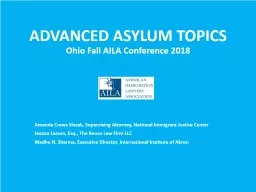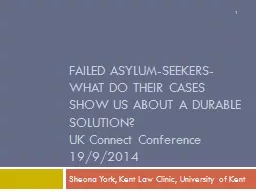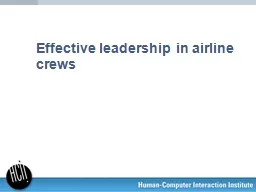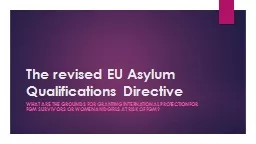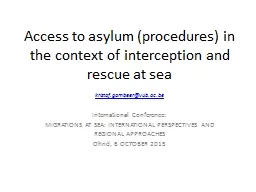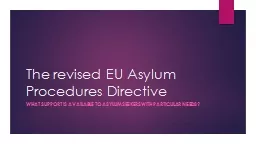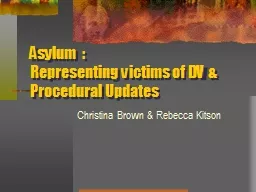PPT-Advanced Asylum Topics Amanda Crews Slezak, Supervising Attorney, National Immigrant
Author : tawny-fly | Published Date : 2019-10-31
Advanced Asylum Topics Amanda Crews Slezak Supervising Attorney National Immigrant Justice Center Jessica Larson Esq The Benos Law Firm LLC Madhu N Sharma Executive
Presentation Embed Code
Download Presentation
Download Presentation The PPT/PDF document "Advanced Asylum Topics Amanda Crews Sle..." is the property of its rightful owner. Permission is granted to download and print the materials on this website for personal, non-commercial use only, and to display it on your personal computer provided you do not modify the materials and that you retain all copyright notices contained in the materials. By downloading content from our website, you accept the terms of this agreement.
Advanced Asylum Topics Amanda Crews Slezak, Supervising Attorney, National Immigrant: Transcript
Advanced Asylum Topics Amanda Crews Slezak Supervising Attorney National Immigrant Justice Center Jessica Larson Esq The Benos Law Firm LLC Madhu N Sharma Executive Director International Institute of Akron. SUMMARY . Workshop on the Israeli Asylum System. Academic Center of Law and Business. November 12-13, 2012. Prof. Stacy . Caplow. Brooklyn . Law School. Detention: Definitions. UNHCR 1999: . Confinement . do their cases show us about . a durable . solution? . UK Connect Conference 19/9/2014. Sheona York, Kent Law Clinic, University of Kent. 1. Kent Law Clinic’s research: ‘. How children become failed asylum-seekers. The Asylum Movement. (. orphanages, jails, hospitals). . Asylums isolated and separated the criminal, the insane, the ill, and the dependent from outside society . “Rehabilitation”. . The goal of care in asylums, which had focused on confinement, shifted to the reform of personal character. Maryam Zoma. Social Work Intern. Seafarers and International House. Silberman. School of Social Work at Hunter College. Asylum Seeker and Immigrant Detainee Projects. What is an asylum seeker?. An individual outside . November 3, 2014. Rachel Prandini, Unaccompanied Minor Law Fellow/Attorney,. Immigrant Legal Resource Center. Immigrant Legal Resource Center. (ILRC). 2. © 2014 Immigrant Legal Resource . Center. SB 873: New Unaccompanied . 2016 Challenge. Outline. Challenge . Background. Challenge . Details. Reasons to . Participate. Evidence of . Effectiveness. How to . Participate. Questions?. Navy and Marine Corps Public Health Center. Good teamwork in aircraft crews (. Ginnett. ) & hospital teams (K-P). Aircraft crews. Hospital teams. Good teamwork in aircraft crews (Ginner) & hospital teams (K-P). Aircraft crews. Highly interdependent task. Civil society organisation Magdalenium. . Non stop tel: 776 718 459 magdalenium2. @. volny.cz. www.magdalenium.cz. Bc. Hýbnerová Lenka. Civil society organisation . Magdalenium . Established in 1997. What are the grounds for granting international protection for FGM survivors or women and girls at risk of FGM?. What’s new?. The grounds for granting international protection have been clarified. The asylum decision-making process is to be made more robust. kristof.gombeer@vub.ac.be. . International Conference:. MIGRATIONS AT SEA: INTERNATIONAL PERSPECTIVES AND REGIONAL APPROACHES. Ohrid, 6 OCTOBER 2015. Key points in presentation. The EU/Mediterranean context. Districts and Educator Preparation Programs Working Together to Support Novice Teachers . November 2015 Regional Meetings. Do Now Activity: . Mix it up! Sit with another district or . ed. prep team rather than with folks you already know.. What support is available to asylum seekers with particular needs?. What’s new?. Asylum decisions to be fairer, quicker and better quality.. Asylum seekers with particular needs are to receive the necessary support to explain their claim.. Christina Brown & Rebecca Kitson . What we will cover . Latest changes in the law . Representing victims of DV. Issues with procedure . Lodging versus filing . One year filing deadline . Using expert witnesses .
Download Document
Here is the link to download the presentation.
"Advanced Asylum Topics Amanda Crews Slezak, Supervising Attorney, National Immigrant"The content belongs to its owner. You may download and print it for personal use, without modification, and keep all copyright notices. By downloading, you agree to these terms.
Related Documents

